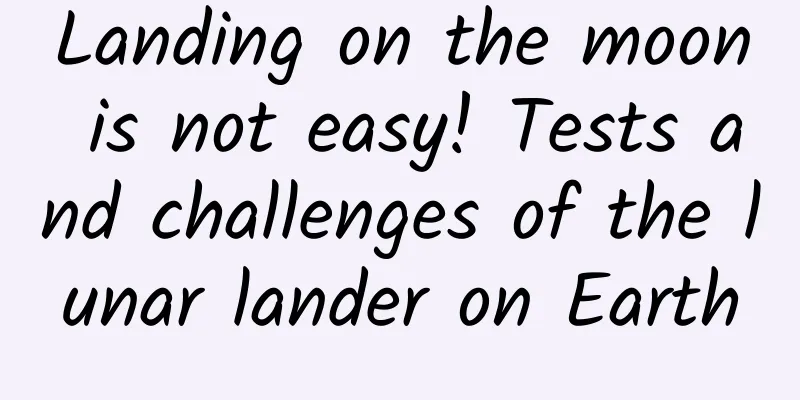Landing on the moon is not easy! Tests and challenges of the lunar lander on Earth

|
source,src As the world's enthusiasm for space exploration grows, lunar landers have become a key technology that space agencies and commercial companies around the world are competing to develop. However, successfully landing on the lunar surface is not easy, and there are many challenges and key tests involved. This article will take you through the testing process of the lunar lander on Earth and the various challenges it faces. 1. Challenges of Lunar Lander 1. Withstand the load: The lunar lander will be subjected to strong vibration and roar during the launch process and needs to be tested in an acoustic chamber to simulate the launch sound and vibration. 2. Harsh space environment: Lunar landers will need to withstand near-vacuum conditions, fast-moving orbits, and harsh sunlight that is not filtered by the Earth's atmosphere, which will cause the lander to experience rapid and large temperature changes and may cause radiation damage to electronic equipment. 3. Autonomous operation: Due to the delay in two-way communications between the Earth and the Moon, the lunar lander must have the ability to operate autonomously. 4. Hardware and software working together: Protect the lunar lander from the harsh space environment and ensure that the hardware and software work together as expected. 2. Testing of the Lunar Lander 1. Load testing: Testing the structural integrity of the lander in simulated sound and its ability to withstand various loads. 2. Thermal Vacuum Testing: Spend days, weeks or months in a thermal vacuum chamber to simulate the vacuum, temperature fluctuations and sunlight radiation found in space and on the moon. 3. Communications and navigation tests: Check the lander's communications equipment antenna and navigation system to ensure they function properly on the Moon. 4. Simulated lunar landing: Test the lander's autonomous operation capabilities by simulating key milestones, such as reaching lunar orbit. 5. Hardware and software collaboration testing: Ensure that the lander's hardware and software can work properly in the lunar environment. 6. Simulated failures: Test the lander’s ability to cope with various extreme landing scenarios and recover from a trajectory that deviates from its orbit. 3. Testing and practical application on Earth Conducting various tests on Earth can provide strong guarantees for the practical application of lunar landers. For example, the US VIPER rover mission tests wheel slippage, sinking and traction in simulated terrain to ensure its normal operation in the rocky terrain of the lunar south pole. However, there are still some aspects of space travel that cannot be tested on Earth, such as the performance of the lander's propulsion system. To this end, scientists have built a system to compare the expected thrust with the actual thrust to see how much the lander's performance deviates. At the same time, reserve propellant is to make up for this difference. Summarize The challenges and tests of lunar landers are key to space exploration. Through various tests on Earth, scientists can better understand and solve the problems that lunar landers may encounter in practical applications. With the continuous development of technology, I believe we will be able to successfully achieve lunar landing in the future and open a new chapter for human space exploration. References: How to test a Moon landing from Earth https://www.nature.com/articles/d41586-024-00352-w |
<<: How filling can Cantonese cuisine be?
>>: How many steps are needed to “eat” a dragon?
Recommend
Kobe Bryant endorses Ele.me, and it only takes five steps to pass the level!
These days, Kris Wu is the spokesperson for Honor...
Detailed explanation of the new information about Douyin live broadcast permissions
The way to play Douyin is constantly changing, an...
Reveal the secrets of making money on short video platforms that you don’t know about, and help you easily master short videos!
Reveal the secrets of making money on short video...
Can Douyin Enterprise Accounts advertise? Is Douyin’s Blue V certification permanent?
As of February 2020, there are more than 500,000 ...
How to promote conversion by operating local life circle mini program?
2021 is almost a month away, and it is less than ...
Tik Tok e-commerce marketing system!
Relying on a huge content ecosystem and interest-...
How to promote Baidu Q&A? How does Baidu Q&A make money?
Nowadays, Baidu's own products are ranking hi...
What is the significance of "culturing human pluripotent stem cells from induced somatic cells" to humans?
Recently, the latest achievement of Chinese scien...
7 challenges facing Apple Watch app developers
The Apple Watch, which goes on sale for the first...
Cheating methods in APP promotion channels, how to prevent cheating in APP promotion?
Cheating often occurs in APP promotion channels. ...
Why is it harder to grab red envelopes this year? Plugins are the culprit
The red envelopes developed by the WeChat team in...
If you don’t want the pressure cooker to explode, you must do this step right! !
There is an exploding pressure cooker in everyone...
What are the Android emulator detection methods?
The general method of detecting the Android emula...
Wuyishan SEO Training: How can online advertising promotion increase Baidu’s trust in your website?
For some new sites, sometimes we publish articles...
[Case] How does an e-commerce app develop an operation and promotion strategy from scratch?
Through this article, you can learn how to formul...









